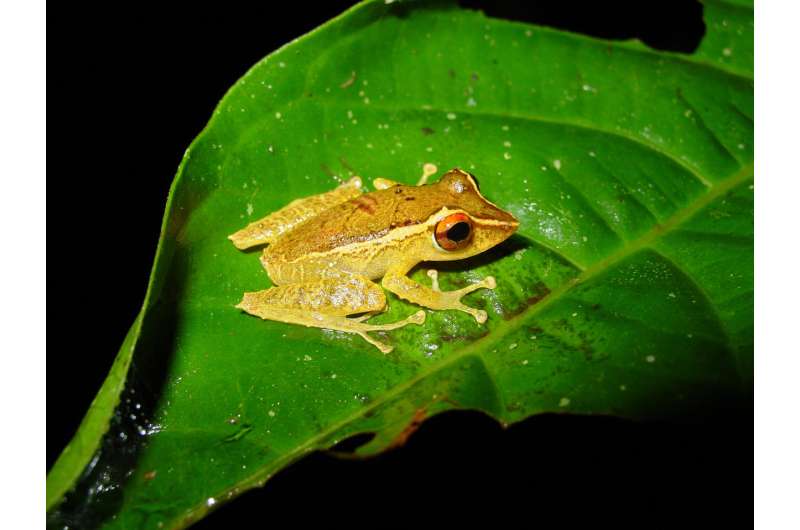An elegant Pristamantis frog in the streams of Panama. Credit: Cori Richards-Zawacki
Black plague killed between 30 to 50 percent of people worldwide. The cause, Yersinia pestis, is still around, but people are not dying of the plague. An even more devastating modern disease caused by the chytrid fungus wiped entire frog and salamander populations off the map. New results from work at the Smithsonian Tropical Research Institute (STRI) in Panama published in the Mar. 29 edition of Science, reveal the outcomes of the chytridiomycosis epidemic and their implications for diseases of mass destruction.
"Imagine a deadly disease that affects not only humans but other mammal species like dogs, cats and cows," said Roberto Ibañez, STRI staff scientist and in-country director of the Panama Amphibian Rescue and Conservation Project. "Chytridiomycosis kills off most of the individuals in many different species of amphibians, but it usually stops short of driving them to complete extinction."
"We were lucky that Karen Lips, now at the University of Maryland in College Park and colleagues saw this epidemic coming into Panama from Costa Rica, and we were able to study both the frogs and the disease before, during and after the peak of the epidemic," Ibañez said.
Disease outbreaks rarely annihilate the host species, because pathogens need their hosts in order to survive and reproduce.
"Because we have pathogen and host samples from before, during and after the epidemic, we can ask whether some frogs survived because the pathogen grew weaker through time, or because the frogs' immune systems or resistance increased through time," said Jamie Voyles, disease ecologist at the University of Nevada, Reno, and first author of the paper.
Scientists take diagnostic samples to test for disease in a glass frog. Credit: Jamie Voyles
The authors tracked changes in amphibian species numbers and communities, infection patterns, host resistance and pathogen virulence for several decades hoping to see evidence of a weaker pathogen and/or of host resistance. The disease-causing fungus, Batrachochytrium dendrobatidis, first appeared in El Cope, Panama, in 2004, in El Valle in 2006 and in Campana National Park in 2007. Between five and 13 years after the epidemic, the authors saw evidence of some recovery in nine species, but the fungus was still present.
There was no evidence that the pathogen grew more slowly, responded differently to skin secretions from the frogs or became less virulent.
However, skin secretions from wild frogs that survived the epidemic inhibited growth of the fungus significantly more than secretions from frogs moved into captive breeding programs before the disease arrived. Researchers think that wild frogs became more resistant to the disease.
"The Panama Amphibian Rescue and Conservation Project collected healthy frogs before the outbreak," Ibañez said. "We learned to breed them in captivity and are now releasing Atelopus varius in areas where the epidemic has passed, so it is extremely important for us to realize that the defenses of these frogs may be weaker than the defenses of frogs that survived the epidemic in the wild."
It is vital to understand how disease transitions work—from outbreak, to epidemic, to coexistence—and our results have implications for a skyrocketing human population facing emerging diseases with the potential to cause global pandemics," said Ibañez.
More information: J. Voyles el al., "Shifts in disease dynamics in a tropical amphibian assemblage are not due to pathogen attenuation," Science (2018). science.sciencemag.org/cgi/doi … 1126/science.aao4806
Journal information: Science
Provided by Smithsonian Tropical Research Institute
























